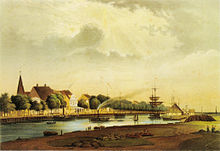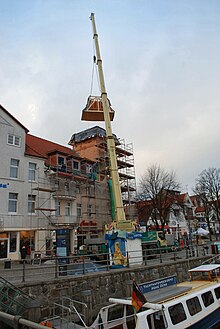Hotel "Am Alten Strom"
The hotel "Am Alten Strom" is a hotel located directly on the Alter Strom in Warnemünde . The more than 150-year history of the hotel begins with the development of tourism on the Baltic Sea . The hotel consists of two buildings: Am Strom 60 and Am Strom 61 . It houses 79 rooms and has been run by the owner Helmut Jahn since 1992.
The story from 1831 to 1942
Right next to the oldest house in Warnemünde, the Vogtei , the innkeeper Burmeister Am Strom 60 opened his hotel in 1831 . In addition to 18 rooms, there was also a stable building for horses. In 1867 the Grand Ducal Secondary Customs Office moved into the house. It now served as a service building and residence for the customs officers. W. Banselow opened an inn on Strom 61 in the same year. The St. Nikolai Church was located directly behind both buildings. The predecessor church of the Evangelical Lutheran Church Warnemünde was built here in the 13th century.
With the development of tourism on the Baltic Sea, more and more accommodation establishments emerged in Warnemünde. In 1872, the innkeeper Berthold Kiehn ran the "Ostseehotel" on Am Strom 61 . In 1877 Kiehn wanted to sell the hotel, but died before it came to that. A buyer could not be found until 1881, and in the meantime the hotel operations were maintained by several managing directors. These were ordered by Kiehn's heirs. Carl Hosmann was the new owner. The "Ostseehotel" became "Hosmanns Hotel". The spa industry became more and more an important economic factor. Hoteliers and restaurateurs began to attract their guests' attention. In a brochure, Hosmann advertised its “comfortably furnished lodging rooms” as well as the “large. Concert garden sheltered from the wind ”.
In 1888 Carl Hosmann sold the hotel to Otto Scholz, who in 1892 also acquired the house at Am Strom 60 and thus ran into economic difficulties. He could only continue to run “Hosmanns Pension”. "Hosmanns Hotel" was put up for auction. The auction was not successful until 1898 and the merchant Max Ebert bought the hotel. The hotel name remained and Ebert appointed the managing director Friedrich Steffen. He bought the house a little later.
"Hosmanns Pension" was acquired in 1905 by the merchant G. Christeinicke and run as the "Hotel Garni Union". In 1911 Friedrich Steffen had “Hosmanns Hotel” replaced by a new building. One of the first reinforced concrete buildings in Mecklenburg was built according to the plans of the Rostock architects Alfred Krause & Paul Korff . The imposing tower of the new house, visible from afar, changed the silhouette on the Alter Strom. Friedrich Steffen died during the construction period and his widow Frieda Steffen took over the management of the hotel. The maintenance of the business was not an easy matter and so the widow Steffen tried to keep the house in 1915. She applied for the adjoining building to be used for serving beer. This was granted to her for the duration of the summer months. In 1920 Frieda Steffen was forced to give up "Hosmanns Hotel".
The new owner was Paul Schlemmer in the same year, who changed the hotel name to “Hotel Reichshof”. Schlemmer ran the hotel until 1927, when he sold it to Theodor Schmude. In 1933 his daughter Martha Kähler took over the management of the company, which she had to give up after a short time. The innkeeper Carl Buggenthin was the manager of the house. He applied to the Rostock District Court for deputy permission. Due to various previous convictions, however, this was not granted to him, his wife Marie received the concession to run the hotel in 1934. The Buggenthin family became the owners of the "Hotel Reichshof".
In 1942 a fire bomb hit the "Hotel Reichshof". The proximity of Arado Flugzeugwerke GmbH was probably the reason for the bombing at this point. The roof of the house burned down and the hotel got a makeshift new roof. However, the tower was not rebuilt.
The times of the FDGB
In 1945 Carl Buggenthin was shot. His wife Marie continued to run the hotel until she handed it over to her daughter Anny Clavier. In the course of Aktion Rose , Anny Clavier also had to hand over her hotel to the FDGB . The owners of the "Hotel Union" - the Christeinicke family - were not affected by the expropriation, but sold their property to the FDGB holiday service.
Both hotels were operated from 1958 by the FDGB as "Recreation Home Am Alten Strom". During this time there was a breakthrough on the first floor. This connected the two buildings. The accommodation business ran here until the end of the GDR . FDGB holidaymakers who were housed in various FDGB properties in Warnemünde were also provided with catering here.
As one of the first special assets of the new federal states, the former "Hotel Reichshof" was transferred to the Buggenthin community of heirs in 1992. Helmut Jahn bought the house in the same year. Anny Clavier's nephew, the attorney Horst Clavier, was responsible for the transaction. Also in 1992 Helmut Jahn applied to the Treuhandanstalt to buy the "Hotel Union" and was awarded the contract.
Back to the private hotel
On May 15, 1992 the hotel “Am Alten Strom” was opened in the style of an FDGB rest home. Shared toilets and showers as well as simple washing facilities in the rooms were the only comforts here.
The breakthrough between the buildings Am Strom 60 and Am Strom 61 has been extended to all floors. Contemporary room furnishings and sanitary facilities within the rooms were built, and shops were created from former offices. The biggest structural change then took place in 1997: the hotel was extended by a new building towards the church square. In 1998 the “Wall of the Best” known among Warnemünders (activists from the Warnemünder Warnowwerft were honored here) had to give way. The hotel got a glass-roofed hotel lobby, additional shops and an underground car park. On May 1, 1999, the opening of the now fully completed hotel was celebrated.
Testimonies to Warnemünde's history
During the excavation work, the foundations of the St. Nikolai Church and the two other predecessor churches as well as well-preserved tiles and colorful broken window glass were exposed. The Warnemünder Friedhof also had its place here until the 19th century. Elaborate archaeological work unearthed human bones from the 14th to 19th centuries. There were also grave goods from the 18th and 19th centuries. A rich fund of evidence of the history of Warnemünde was discovered, from tableware to glass vessels, jewelry, coins, ornaments and book fittings.
The reconstruction of the destroyed tower
The hotelier applied to the responsible authorities to rebuild the historic tower of the former "Hotel Reichshof". This started a legal dispute that lasted three years because the city administration initially rejected the building. The reason for the rejection was that this tower was atypical for Warnemünde and a permit would lead to "land law tensions" (see interior ). Before the Schwerin Administrative Court , Helmut Jahn won the right and the application had to be approved.
Construction of the tower began in late autumn 2008. The view of the house based on historical templates from before 1942 was restored.
swell
- Ostsee-Zeitung from December 12, 1998
- Dieter Eints: "Warnemünder Lokal", Verlag Oll Wernminn, 2009, ISBN 978-3-00-029291-0
Web links
Coordinates: 54 ° 10 ′ 37 ″ N , 12 ° 5 ′ 17 ″ E





